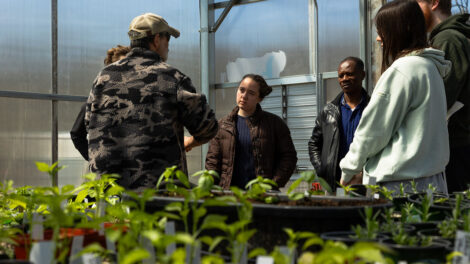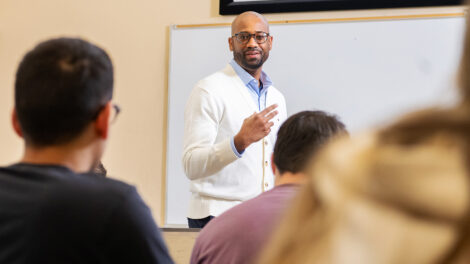Inside the classroom: Shaping minds
Inside the Classroom is a new series offering a glimpse into classes at Lafayette, the talented professors who teach them, and how they impact and define a student’s experience.
By Stella Katsipoutis-Varkanis
In a modern era where everything digital reigns, says Nestor Gil, professor of art, “people are desperate for a material experience.” And that’s precisely what students who take his Sculpture I course get. In the span of a 16-week semester, ART 107 students carve, mold, and build unique creations as Gil guides them through the nearly 40,000-year-old art of sculpture.
Video by Olivia Giralico
“This class isn’t just an opportunity to examine what it is to make in 3D. It’s an opportunity to become familiar with ways of making that are both historic and entirely current in the 21st century,” Gil says. What excites his students most about the course, he adds, is the fact that they can “get their hands dirty” in the art studio. “There’s something special about walking into this class having never swung a hammer or used a jigsaw, and walking out knowing how to use those tools to engage with their own ideas.”
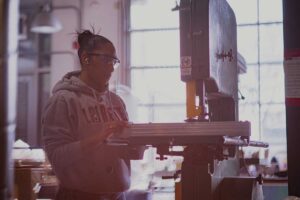
A band saw is one of the many kinds of machinery and hand tools Sculpture I students learn how to use. | Photos by Adam Atkinson
Taught in both spring and fall semesters, Sculpture I attracts students from virtually every major. Gil likens his approach to the course to that of a math class: At the beginning of the semester, student projects involve the subtractive method (carving something out of a single material, like plaster) and then move on to addition (using various materials like wood and chicken wire to build larger sculptures from scratch), multiplication (making molds and castings of a handmade object), and division (of labor, with group projects that require a team effort). To wrap up the semester, students work in groups on a final project of Gil’s choosing. This spring, students crafted larger-than-life inflatable caterpillars, butterflies, and other insects.
“I never thought I’d be melting plastic to create something so fun and beautiful,” says Jennifer Mercado-Cruz ’25, a biology major who took the course in the spring. “The course has helped me gain confidence in working with unfamiliar material.”
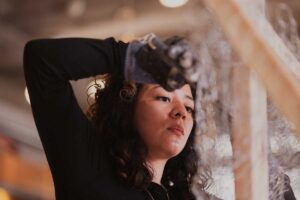
Jennifer Mercado-Cruz ’25 says expanding her artistic horizons has given her a new perspective—one that will serve her well in her future career in crime scene investigation.
Learning to work with their hands isn’t the only thing students glean from the experience. The opportunity to pay close attention to the intricate details in everyday objects and see them from an alternative viewpoint opens up a whole host of possibilities for those who take the class—something they can carry with them into whatever career path they may follow in the future.
“Being able to touch things, manipulate them, and give them form gives you a better understanding of how the world is made—and the kind of labor required to build it,” Gil says. “You will come out of this course understanding the physical and material world in ways you can’t possibly have understood it before.”
Mercado-Cruz, who will be pursuing a master’s degree at Georgetown University starting this fall, says the creative thinking skills she was able to strengthen in Sculpture I will especially come in handy in her chosen field, crime scene investigation. “What I really loved about the course is that it pushed my creative limits,” she says. “Because I’m a biology major, my schedule is often packed with STEM courses. This was a great opportunity for me to explore my passion for art, and I look at things now with a completely different perspective.”
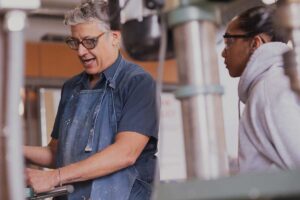
Gil encourages his art students to find beauty in the unexpected.
And thanks to Gil’s support and encouragement throughout the creative process, Mercado-Cruz adds, learning to not fear failure is one of the most important lessons she walked away with after the course was over. “I loved working with Nestor. He’s a great mentor and is incredibly inspiring,” she says. “If something went wrong, he taught us to embrace it. He picked up almost every student from that feeling of failure, and he encouraged us to find beauty in the unexpected. Having access to professors like Nestor at Lafayette, who are extremely skilled at guiding students, is great—and I think I wouldn’t have had the same experience elsewhere.”
Gil encourages students of all majors to take Sculpture I, whether they’re interested in pursuing art in a professional capacity, gaining a robust liberal arts experience, or just giving art a shot because it’s something they’ve always wanted to try.
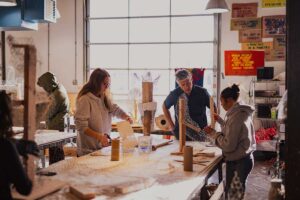
Gil says doing art allows students to discover new possibilities for themselves “that can’t be unlocked anywhere else.”
“Lafayette is a small institution, which gives us many opportunities for close intellectual and creative interactions between the people who are here to teach and those who are here to learn,” he says. “Art is a kind of literacy, and abandoning it because we can’t make a drawing look just right, or because someone told us we’re not good enough at it, is a tragedy. Doing art sets us up for a really beautiful set of experiences where you discover aspects of your own possibility that can’t be unlocked anywhere else. Every single person who ever walks the earth should take an art class.”
Mercado-Cruz emphasizes, “If I could recommend any class to every student at Lafayette, it would be Sculpture I, specifically with Nestor. Experiencing this class with Nestor has been a transformative experience for me.”
